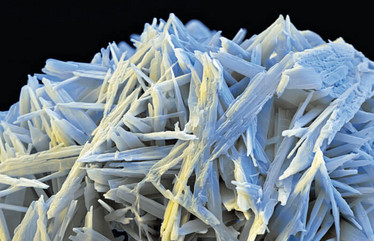
Celebrating PVP in Pharma
PVP has a long pedigree of use in both medicinal and pharma applications – and with innovations continuing to emerge, its use shows no sign of slowing down.
sponsored by BASF

Dr Krizia M Karry’s pharma career began over a decade ago in Puerto Rico. Despite initially focusing on PAT applications, process development and tech transfer, today she is fascinated by the use of excipients in the industry and works as a Global Technical Marketing Manager for Pharma Solutions, at BASF. Here, Dr Karry explains what led her to join BASF and the lessons she has learned about one of the industry’s most popular excipients: PVP.
How did you join BASF?
After several years in the industry I decided to pursue graduate studies in the US. I focused my thesis on pharma challenges at the time: formulation and process design for poorly soluble compounds, and multipurpose manufacturing platforms for different types of dosage forms.
As soon as I graduated, I returned to the pharma industry where, in collaboration with R&D scientists, I scaled-up, transferred and validated processes for manufacturing tablets via high shear wet granulation, roller compaction, fluid bed coating and continuous manufacturing platforms. Interestingly, irrespective of the processing platform, one thing was clear: despite being the most crucial part of a pharmaceutical product, raw materials were the least understood systems! In realizing this I decided to join BASF, a technically-driven excipient manufacturer that is resourceful in generating a body of knowledge on its excipients to then share with its customers, my “previous” pharma peers.
What is the story behind the use of PVP in the pharma industry?
The PVP history is one that we are proud of at BASF. More than 80 years ago, the chemists of our Ludwigshafen plant in Germany mastered acetylene-chemistry to produce – in just five steps – a new monomer called N-vinylpyrrolidone. According to a 1939 patent by BASF chemist Walter Reppe, vinyl pyrrolidone reacted in the presence of catalysts to form the polymer we now know as poly vinylpyrrolidone – or PVP. This initial application data regarded PVP as an additive in the textile industry due to its great affinity to dyes, and as a binder and thickening agent.
During this same time (1940s), the Second World War was ramping up and access to blood plasma in Germany was extremely difficult. Critically wounded soldiers were treated with blood plasma to maintain the body’s blood volume and minimize the chances of going into shock due to low blood pressure. By the end of 1940, BASF’s Kollidon® PVP gained its first medicinal application as a synthetic blood plasma substitute. Its use was simple: Kollidon® was combined with water and inorganic salts and used in intravenous infusions. The higher the PVP content, the greater its efficacy in maintaining blood volume. The application was patented in 1941 by Walter Reppe and researchers from Bayer pharmacological laboratories.
In the subsequent years, PVP continued to gain interest in different fields and for a wide variety of applications due to its properties as a non-irritant, non-toxic, colorless, water-soluble polymer with excellent binding, wetting and film-forming properties. Today, PVP excipients are everywhere. In pharma, PVP is commonly used as a tablet binder, disintegrant, pore former and solubilizer.
In what way has PVP evolved over the years?
The hygroscopic properties of PVP have long been exploited in fluid bed and wet granulation processes for their correlation to high binding, wetting and granulating efficiencies. Moreover, PVP chemistry has evolved so that less hygroscopic copolymers are now available. For example, Kollidon® VA 64 and VA 64 Fine absorb three times less water than povidone at a given relative humidity whilst offering excellent dry binding properties – the latter being an excellent choice for roller compaction and direct compression continuous manufacturing applications.
As part of the PVP evolution, we have also considered the major oxidation impurities of the polymer (residual peroxides, formaldehyde and formic acid) and how to address our customers’ needs in formulating oxygen-sensitive APIs. We have developed and introduced a low peroxide (LP) grade, Kollidon® 30 LP, that contains a sulphite-based antioxidant. Additionally, this product, as well as other PVP grades, are packaged employing BASF’s patented PeroXeal® packaging. This packaging concept is another option we offer for further reducing peroxide formation in APIs and drug products. It is based on a combination of several components: an oxygen-impermeable inner liner, and a filling process under inert conditions. The result is a significantly lower risk of oxidation that allowed BASF to extend the shelf life of its PVP grades for up to four years for products that come with the PeroXeal® packaging.

What do you think have been the most important PVP products to emerge?
Kollidon® 30 is still one of the most important products in our PVP portfolio – and I believe it will remain a standard excipient in the formulator’s toolbox because of its excellent processability, long shelf life and amenability to almost all processing platforms.
We have also seen a growing interest in crospovidone (Kollidon® CL grades) as the “superdisintegrant” of choice for tablet applications, as well as more recently as a “binding disintegrant”. As a binding disintegrant, we found that tablet strength was inversely correlated with crospovidone particle size in formulations containing both crospovidone and cellulose components, but formulations containing mainly brittle ingredients, allowed a proper binding of crospovidone during tabletting. As a result, tablet strength became less affected by the particle size of crospovidone.
We have developed a unique portfolio of crospovidones, covering both monograph type A and B as well as different applications: crospovidone type A Kollidon® CL, the standard superdisintegrant and Kollidon® CL-F with a finer particle size for improved tablet strength and surface quality; and the type B products Kollidon® CL-SF and Kollidon® CL-M – the SF grade being the ideal disintegrant for orally disintegrating dosage forms as it provides a creamy mouth feel rather than having a gritty texture due to its super-fine particle size, and the M grade as a micronized product suitable for roller compaction, and as a suspension stabilizer and pore former in sustained release applications.
PVP is not the only formulation option available. Why would formulators choose PVP over different options?
PVP has a proven track record in the pharma industry as a safe, multi-functional excipient. Specifically, its excellent solubility in water and other solvents make it a versatile excipient for almost all dosage forms, including wet granulation for solids production, solutions, syrups, injectables, and topicals. Its wetting and binding powers are an advantage for wet granulation, dry granulation and tabletting operations as they lead to compacts with higher tensile strengths. At the same time, its swelling properties make it an excellent tablet disintegrant even at very low concentrations. Its excellent film-forming properties can also be leveraged in coating formulations, oral films, ophthalmic solutions and flexible transdermal patches. And lastly, its chemical structure allows it to form chemical complexes with many APIs. This is leveraged by pharmaceutical formulators to improve drug solubility in liquid dosage forms (e.g., antibiotics), increase drug dissolution rate in oral dosage forms, and reduce drug toxicity (e.g., injectables and iodine).
How do you think PVP options will continue to expand in the future?
Solid oral dosage forms will remain the main driver for pharma developments and here PVP – soluble or insoluble – will continue to play an important role. However, we know that close to 70 percent of new molecular entities in pharma pipelines are poorly soluble compounds. To front this challenge, we are working closely with formulators to expand their toolboxes to include PVP copolymers (such as Kollidon® VA 64) that have high drug solubilization capacities and storage stabilities, and that are amenable to typical solid dispersion processing methods, such as hot-melt extrusion and spray drying.
In the future, I believe excipient options will also continue to grow. Despite the widespread use of excipients across numerous industries, they are oftentimes one of the least understood systems. In working in the pharmaceutical industry and now at BASF, I see we continue asking the same questions, such as which parameters should be used to properly characterize electrostatics and flowability, and what raw material properties are relevant for continuous manufacturing. By working together and sharing knowledge around excipients, we can finally answer these questions and design excipients that are “fit-for-use”. These partnerships will certainly give manufacturers the confidence they need to use newer excipients.

Making great scientific magazines isn’t just about delivering knowledge and high quality content; it’s also about packaging these in the right words to ensure that someone is truly inspired by a topic. My passion is ensuring that our authors’ expertise is presented as a seamless and enjoyable reading experience, whether in print, in digital or on social media. I’ve spent fourteen years writing and editing features for scientific and manufacturing publications, and in making this content engaging and accessible without sacrificing its scientific integrity. There is nothing better than a magazine with great content that feels great to read.



















